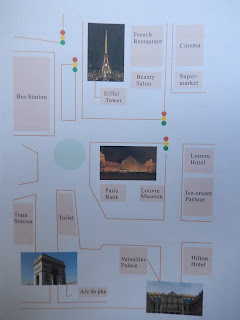Lesson Level:
Junior 2 Duration:
40 Minutes
Lesson
Title:
Pizza!
Grammar
and Vocabulary
Food
vocabulary
Toppings
for pizza
Lesson
Objectives
Students
will be able to list various foods that can be used on pizza.
Students
will discuss toppings and design a new pizza.
Students
will present their new pizza to the class.
Students
will practice note taking.
Materials
Required
Picture
of a pizza.
Enough
copies of a menu to give one per group.1
Ball
for ball toss activity.
Preparation
Find
and print a good picture of a pizza.
Procedure
1
Write
Pizza on the board.
Show
picture of a pizza
2
Ask
students if they like pizza. Ask them what kind of food can go on a
pizza.
3
Put
students into groups of four.
Give
each group a copy of the menu.
Go
through the vocabulary from the menu, elicit or explain meanings of
all words.
Write
new definitions on the board.
4
Tell
each group they must choose a pizza to order.
Allow
two minutes only to choose.
Ask
each group which pizza they chose and why.
5.
Design
a new pizza for the menu on the board.
Ask
students for new toppings to go on menu.
Write
their suggestions on the board.
Choose
some toppings.
Ask
class to come up with a name.
Write
the new description on the board.
6
Put
these instructions on the board.
Each
group
you
will create a new pizza
what
toppings will you put on your pizza
give
your new pizza a name
choose
someone in your group to tell the class about your pizza
7
Allow
five minutes to create the pizzas.
Monitor
and help if necessary.
8
Tell
class that they will now hear about each pizza.
They
must make notes.
Ask
each group in turn for their name and description.
Write
the names on the board and keep a note (not shown to class) of each
pizzas ingredients.
9
Tell
class they must now all choose between the new creations.
Take
a vote by show of hands.
10
Extension
task
Ball toss to ask students
which ingredients were on which pizza. (Using the note that was made
in 8)
Notes
1. menu
Perfect
Pizzas
All our pizzas
can be ordered as thin crust or thick crust.
All our pizzas
include delicious tomato sauce and cheese toppings
Plain
Simple, but delicious,
cheese and tomato pizza.
Hawaiian
Ham, pineapple, cheese
and tomato.
Pepperoni
Pepperoni, cheese and
tomato.
Hot and Spicy
Beef, chili, peppers,
tomato and cheese
Chicken and Mushroom
Chicken, mushroom,
peppers, tomato and cheese.
Spicy Vegetarian
Peppers, chili, mushroom,
corn, tomato and cheese
Seafood
Shellfish, anchovies,
olives, tomato and cheese.






